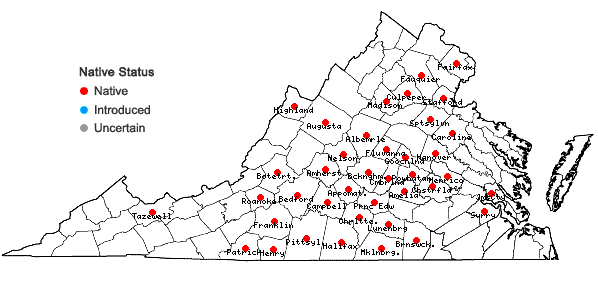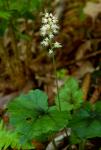Tiarella cordifolia L.

Show image without county labels
Detail
- Family
- Saxifragaceae
- Botanical Name
- Tiarella cordifolia L.
- Common Name
- Heartleaf Foamflower
- Synonym(s)
- Tiarella cordifolia L. var. collina Wherry
- Flora of Virginia Name/Status
- Tiarella cordifolia L. (sensu lato)
- Comments
- Treatment follows Nesom’s recent revision of the genus in e. North America (Phytoneuron 31: 1-61, July 2021), which argues that taxa formerly recognized as varieties of Tiarella cordifolia merit species rank. Two species – Tiarella cordifolia and T. stolonifera – are attributed to Virginia. Although differing in several characters, these taxa are readily distinguished by habit in the field, with T. cordifolia forming discreet clumps and lacking the stoloniferous habit so typical of T. stolonifera. Additionally, the two are quite distinct geographically, with T. stolonifera nearly restricted to the mountains and T. cordifolia occurring primarily east of the mountains. Tiarella austrina (Lakela) Nesom, based on more elongate terminal lobe on leaf and only shallowly toothed compared with the typical variety, was mapped in far sw. Virginia in Amer. J. Bot, 1937, but a supporting specimen has not been seen and the record seems well out of range based on Nesom (2021). A modern molecular phylogenetic study would help clarify the relationships of all five taxa of eastern North American Tiarella.
Tiarella cordifolia is the most widespread species species in Virginia, occurring throughout the Piedmont, with a few occurrences in the n. Coastal Plain and lower elevations of the mountains. The current map is based on the map in Nesom (2021), modified slightly by Virginia herbarium data. Nesom demonstrates that John Clayton’s type of Tiarella cordifolia was collected in eastern Virginia, the name thus applying to the taxon formerly called T. cordifolia var. collina. Consequently, the montane taxon formerly called T. cordifolia var. cordifolia was given the new name Tiarella stolonifera.
- Habitat
- Tiarella cordifolia occurs in mesic to dry-mesic slope forests, ravines, and well-drained alluvial forests, usually in moderately to strongly base-rich soils. It is frequent throughout the c. and s. Piedmont; infrequent in the n. Piedmont, and rare in the mountains (low elevations) and inner Coastal Plain.
- Native Status
- Native
To save this map, right-click (control-click for Mac users) on the map and choose "Save Image As...".




